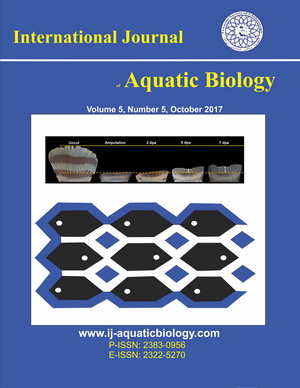Molecular identification of two tilapia species of the genus Oreochromis from Shat Alarab River
Downloads
In the current study, the two species of Tilapia, including Oreochromis niloticus and O. aureus, collected from Shat Alarab River in the Basrah region, South of Iraq, were identified using the nuclear sox3 gene to confirm their genetic matching. They have been recorded since 2007 in the middle part of Shat Alarab River, Iraq based on morphometric characters; however, there is no evidence to prove how these two species were introduced into the Iraqi inland waters. After collection, morphological characteristics of specimens, including meristic measurement, were counted to identify the two species. Then, their phylogenetic relationship with other available genes from different geographical regions was constructed using maximum likelihood and neighbor-joining algorithms. The results revealed that both species did not belong to a common ancestor. Furthermore, the results confirmed that Scan4ab existed in O. niloticus, but it was not found in O. aureus, showing they are probably not taxonomically related.
Downloads
Anene A. (1998). Survey of the abundance of fish of Umnuoseriche Lake in the Niger Delta floodplains, Nigeria. Journal Of Life Science Innovation, 3: 15-27.
Challa S., Neelapu N. (2019). Phylogenetic trees: Applications, construction, and assessment. In: K. Hakeem, N. Shaik, B. Banaganapalli, R. Elango (Eds.), Essentials of Bioinformatics. Volume 3, Springer Nature, Cham, Switzerland. pp: 167-192.
Dunz A., Schliewen U. (2013). Molecular phylogeny and revised classification of the haplotilapiine cichlid fishes formerly referred to as “Tilapia”. Molecular Phylogenetic and Evolution, 1(68): 64-80.
Durr J., Gonzalez J. (2002). Feeding habits of Beryx splendens and Beryx decadactylus (Berycidae) off the Canary Islands. Fish Research, 54: 363-374.
Froese R., Pauly D. (2023). FishBase. World Wide Web electronic publication.
www.fishbase.org, version (10/2023).
Ford A., Bullen T., Pang L., Genner M., Bills R., Flour T., Ngatunga P., Rüber L., Schliewen U., Seehausen O., Shechonge A., Stiassny M., Turner G., Day J. (2019). Molecular phylogeny of Oreochromis (Cichlidae: Oreochromini) reveals mito-nuclear discordance and multiple colonisation of adverse aquatic environments. Molecular Phylogenetic and Evolution, 136: 215-226.
Jalili P., Eagderi S., Poorbagher H., Herrel A. (2022). Effect of morphological development on the locomotion function of Nile tilapia, Oreochromis niluticus during early ontogeny. Journal of Marine Biology. 13(1):
King R. (1994). Fecundity of Tilapia mariae in small tropical stream. Ph. D. Thesis, port Harcourt University, port Harcourt, Rivers State, Nigeria. 235 p.
Klett V., Meyer A. (2002). What, if anything, is a tilapia? Mitochondrial ND2 phylogeny of tilapiines and the evolution of parental care systems in the African cichlid fishes. Molecular Biology and Evolution, 19: 865-883.
Matschiner M., Musilová Z., Barth J., Starostová Z., Salzburger W., Steel M., Bouckaert R. (2017). Bayesian Phylogenetic Estimation of Clade Ages Supports Trans-Atlantic Dispersal of Cichlid Fishes. Systematic Biology, 66(1): 3-22.
Nagl S., Mayer W., Samonte I., McAndrew I., Klein J. (2001). Classification and Phylogenetic Relationships of African Tilapiine Fishes Inferred from Mitochondrial DNA Sequences. Molecular Phylogenetic and Evolution, 3(20): 361-374.
Novak A., Taylor A., Pineda R., Lasda L., Wright M., Ribera A.B. (2006). Embryonic and larval expression of zebrafish voltage-gated sodium channel ?-subunit genes. Development Dynamics, 235(7): 1962-1973.
Philippart C., Ruwet J. (1982). Ecology and distribution of tilapias. In: R.S.V. Pullin, R.H. Lowe McConnell (Eds.). The Biology and Culture of Tilapias, Proceedings of the 7th ICLARM Conference, Manila, Philippines. 1982: 15-59.
Radkhah A.R., Eagderi S. (2021). Ecological consequences of tilapia species on fish biodiversity of Iran and challenges arising from their introduction. Iranian Journal of Ichthyology, 8(4): 342-350.
Saleh K. (2007). First recorded of Tilapia zilli (Gervais, 1848), in natural water of Iraq (Tigris River). Proceedings of 1st University of Basrah Scientific Conference of Agricultures College, 2007.
Schwarzer J., Misof B., Tautz D. (2009). The root of the East African cichlid radiations. BMC Evolution Biology, 9: 186.
Singh U.R., Deb R., Alyethodi R., Alex R., Kumar S., Chakraborty S., Dhama K., Sharma A. (2014). Molecular markers and their applications in cattle genetic research: a review. Biomarkers Genomic Medicine, 6: 49-58.
Snoeks J. (2000). How Well Known Is the Ichyodiversity of the Large East African Lakes? Advances in Ecological Research, 31: 17-38.
Tesfaye G., Curto M., Meulenbroek P. (2021). Genetic diversity of Nile tilapia (Oreochromis niloticus) populations in Ethiopia: insights from nuclear DNA microsatellites and implications for conservation. BMC Ecology. Evolution, 21: 113.
Triantafyllidis A., Bobori D., Koliamitra C., Gbandi E., Mpanti M., Petriki O. (2011). DNA barcoding analysis of fish species diversity in four north Greek lakes. Mitochondrial DNA, 22: 37-42.
Turner G., Seehausen O., Knight M., Allender C., Robinson R. (2001). How many species of cichlid fishes are there in African lakes? Molecular Ecology, 10: 793-806.
Yousef O., Goda A. (1996). Modern technologies for the commercial production of fish. Arab House for publication and distribution. Cairo, Egypt. 709 p.
Zhang J., Hanner R. (2011). DNA barcoding is a useful tool for the identification of marine fishes from Japan. Biochemical and Systematics and Ecology, 39(1): 31-42.
Copyright (c) 2024 International Journal of Aquatic Biology

This work is licensed under a Creative Commons Attribution 4.0 International License.








